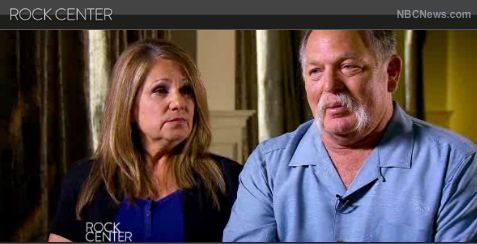 By now you’ve no doubt heard that Tom Cruise has filed a $50 million lawsuit against Bauer Publishing and two of its magazines, Life & Style and In Touch, for claiming on the covers of a couple of issues in July that, following his divorce to Katie Holmes, Cruise had “abandoned” his daughter, Suri.
By now you’ve no doubt heard that Tom Cruise has filed a $50 million lawsuit against Bauer Publishing and two of its magazines, Life & Style and In Touch, for claiming on the covers of a couple of issues in July that, following his divorce to Katie Holmes, Cruise had “abandoned” his daughter, Suri.
Cruise, in a complaint filed by his attorney, Bert Fields, accuses the magazines of writing checks on their covers that they couldn’t cash inside — in other words, the stories themselves didn’t have facts proving that Cruise had “abandoned” his daughter. While Tom did have a heavy work schedule following the divorce, Fields insists that the actor at least talked to his daughter on the phone every day.
Well, he may have a point there. But does that mean Cruise is going to get $50 million out of Bauer?
We’ll check in with our legal department in a minute. But first, we wanted to point out that our own reporting on Cruise was very different from what Life & Style and In Touch were promoting.
In fact, we had pointed out that, from a Scientology perspective, Cruise seemed to be getting special dispensation in the opposite direction — according to the rules that rank-and-file church members are subject to, a Scientologist in Cruise’s position would normally be forced to abandon his daughter and her she-devil mother, Katie Holmes, after the way she walked out on him.
But because of who he is, Cruise is clearly getting around the Scientology policy of “disconnection” and can have all the contact he wants with his daughter and ex-wife.
Anyway, we checked in with attorney Scott Pilutik to get his thoughts on Tom’s lawsuit:
Public figures, a category into which Cruise easily fits, have an extremely high burden of proof in US defamation cases, which is why they’re so rarely filed. The burden, per New York Times Co. v. Sullivan, requires the plaintiff to show not only that (1) the statement was false; and (2) that it in fact damaged the plaintiff’s reputation; but also (3) that the publisher *knew* that the offending statement was false (i.e., the “actual malice” standard).
#1 (Falsity) seems easy enough to prove, so we’ll give Tom that one, though Life & Style has a tiny bit of wiggle room if the court is willing to distend the meaning of “abandoned.”
#2 (Harm), however, is problematic because it’s really not clear that he’s been harmed by the Life & Style article. For some categories of defamation you don’t need to show harm because the harm is presumed (e.g., imputation of a loathsome/sexual disease, false statement of professional ability, imputations of criminality, and, often, affiliation with a notorious party, such as the KKK), but the suggestion that someone is a “bad father” isn’t one, so damages must be proved. How do you do that? If you were a private figure you would get testimony from, say, employers who declined to hire you because of the defamatory statement, or neighbors who shunned you. Cruise obviously can’t do that, so perhaps his attorneys can statistically poll his audience via surveys etc.? I can’t imagine that’d be easy.
#3 (Actual Malice), finally, requires Cruise to show that Life & Style knew their headline was false and published it anyway in order to smear Cruise’s name. The reality finds it more likely that Life & Style wanted to sell magazines and were fast and loose with the meaning of “abandoned.” Reckless? Perhaps, and courts will often view recklessness as satisfying the actual malice test. The edge goes to Life & Style here too, but I think the bigger problem for Cruise and Fields will be to show that Cruise’s reputation was damaged by this particular story.
We have to agree with Scott — this lawsuit feels thin. Sure, it will suck up a lot of attention and cost both sides a pretty penny. But in the end, there doesn’t seem to be much to it.
…unless, that is, you were hoping to get the press to stop talking about that other story printed about you recently. You know, the one about filing down incisor teeth, etc.
Clever.
——————————————————–
English Scientologists Fight For the Right To Marry
In what seems a calculated move to gain sympathy at a time when it is reeling from bad press, Church of Scientology officials petitioned London’s High Court yesterday to allow a Scientologist couple to marry at a Scientology church, which is banned in England.Wait a minute. English Scientologists can’t get married at a Scientology org? What kind of a country are you Limeys running over there?
According to the Independent, “religious” marriages can only be performed at officially-recognized “places of worship,” and the English government has refused to grant Scientology churches that status.
Have to admit, our first reaction here in the bunker was to shake our heads at such misguided Old World thinking. After all, over here in the land of the free, our firewall between church and state would never allow such a thing to happen.
After our knees got done jerking, however, we started to wonder if this might actually set up an intriguing court fight there across the pond.
Sure, it might not fit with American values, but why not make Scientology prove to an English court’s satisfaction that listening to L. Ron Hubbard lectures and exploring (with scientific certitude) billion-year-old past lives while hooked up to a jackleg lie detector machine is somehow a form of “worship.”
Hey, that could actually be a pretty good show.
For a UK perspective, we talked to Pete Griffiths, who lives in Ireland but was recently in England to lead a protest by ex-Scientologists of this year’s big International Association of Scientologists gala in East Grinstead.
What did he make of the move by Scientology to get recognition as a “place of worship”?
In my day we knew we weren’t really a religion, but if any outsider dared say so we’d defend our religiousness to the death. It’s classic Scientology hypocrisy and double-think.
——————————————————–
Another Narconon Lawsuit, Filed Days After a Family’s Loss
If you’ve been following the disastrous fortunes of Scientology’s drug rehab program, Narconon, then you probably saw NBC’s August Rock Center episode that featured Shirley and Emmett Gilliam (seen above) discussing with Charles Smith the death of Shirley’s son, Gabriel Graves.
Graves, 32, was one of three Narconon patients at its Oklahoma flagship facility who died within a nine-month period. The deaths are the subject of multiple local and state investigations.
Sadly, on October 16, just weeks after this episode aired, Emmett Gilliam died at only 64 years of age. A former country musician who had worked for Garth Brooks for 22 years, most recently as project manager, Gilliam was memorialized on Saturday in Oklahoma, and Brooks attended and gave a eulogy. The famous musician took time out for the service even though the next day he was installed at the Country Music Hall of Fame in Nashville.
Yesterday, Shirley Gilliam filed a wrongful death suit on behalf of her son, whose cause of death could not be determined by the Oklahoma state Medical Examiner’s Office. Graves died on October 26, 2011, and the Tulsa World unearthed a letter from another patient at the center who described that Graves was suffering from severe headaches as he was going through Narconon’s treatment, consisting of heavy sauna use.
On April 11, Narconon patient Hillary Holten died, and the cause of her death has also not been determined. Stacy Murphy was the third death, on July 20, and investigators are still waiting for the results of her autopsy.
It’s disturbing that the state medical examiner could find no cause of death for Graves and Holten. We asked Gilliam’s attorney, Gary Richardson, who is also representing Robert Murphy in the lawsuit filed in the death of his daughter, Stacy, whether he thought those undetermined causes of death might hurt or help these lawsuits.
“If I had to pick one. I would say help,” he wrote to us. “Can you imagine being paid thousands of dollars to provide care for someone in a ‘controlled’ area, having advertised that you have all these professionals on staff and in excess of 100 staff members, and then have three patients die in less than a year and have no explanation for it? As I say, the first time something happens its an ‘incident,’ the second time it’s a ‘co-incident,’ but the third time it’s a ‘trend’.”








